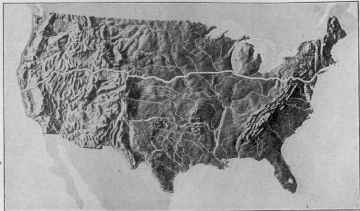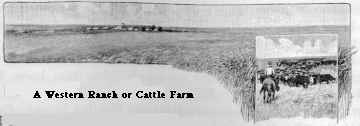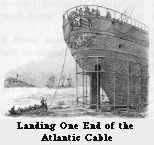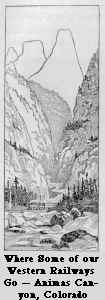Resource Center OLLibrary
|
334 |
|
[1866 |
|
367. The Atlantic Telegraph
Cable. These political events were not the only ones
in which the country was interested. Professor Morse, the
inventor of the telegraph, had predicted (§
|
|
1867-1869] |
|
335 |
Secretary Seward persuaded Congress to make
this purchase, in order to extend our power on the Pacific coast.
Many Congressmen thought it was a waste of money, and one called
Alaska "the refrigerator of the United States." But it has proved
itself to be a very profitable "refrigerator." Its furs, forests,
fish, and mineral deposits are of immense value; and many millions
in gold have been taken from the Yukon and Klondike districts.
Besides buying this new territory the national
government began to pay off the great Civil War debt, amounting to
nearly $3,000,000,000,1 -- a sum so enormous that in
the longest lifetime a person counting out the dollars one by one,
at the rate of sixty a minute, could not get through even a third
of it.
Before all the soldiers had been sent home we
had paid off over $30,000,000. Since then we have paid nearly
$1,200,000,000 more. Had we continued to reduce our debt at the
same rate we should have wiped it out in about fourteen years. No
country in Europe ever voluntarily settled such a debt. To-day our
credit stands as high as that of any nation on the globe.
369. Summary. During President Johnson's
administration six of the seceded states were readmitted to the
Union; but Congress and the President did not agree, and Congress
attempted by impeachment to remove the President from office.
Three amendments to the Constitution -- namely,
the Thirteenth, Fourteenth, and Fifteenth - -were made during Mr.
Johnson's presidency, though the last one was not ratified by the
states until the incoming of the next administration. The first
declared the negro free, the second made him a citizen, the third,
a voter.
The other important events were: (1) the full
pardon of all persons who had fought against the Union; (2) the
beginning of the payment of the national debt; (3) the laying of
the Atlantic cable; (4) the purchase of Alaska.
1 The actual national war debt
was $2,750,000,000. This debt was greatly increased by our war
with Spain (1898), so that at the close of 1907, notwithstanding
all we had paid, it was nearly $2,500,000,000 and on June 30,
1915, it was $3,225,734,627.
|
336 |
|
[1869 |
ULYSSES S. GRANT (REPUBLICAN)1
370. Grant's Administration (Eighteenth
President, Two Terms, 1869-1877); Completion of the Pacific
Railway; what Railways and Telegraphs have done for the Union.
Before the great Civil War broke out the people of California
resolved to have a direct overland mail to the East, instead of
that by the slow and circuitous route through Arizona. Accordingly
a pony express started (1860) to carry letters between Sacramento
and St. Joseph, Missouri, by way of Salt Lake City. This was
followed by a telegraph line (1861). Next, a daily line of
stagecoaches for both passengers and letters was put on the same
route (1861). When Indians attacked these coaches there was wild
work. It was a race for life and a fight for life. But this means
of communication was too slow, and a number of enterprising
Eastern and Western men resolved to build a railway across the
continent to the Pacific.
A little more than two months after General
Grant became President, the last spike of the last rail of the new
road was driven at Ogden, Utah (1869). The blows of the sledge
hammer which drove that spike -- completing the greatest work of
the kind then in the world -- were telegraphed, as they fell,
throughout the Union.2
Congress granted a tract of land in alternate
sections, twenty miles wide, extending from Omaha to San Francisco
in aid of this national enterprise. During the previous
thirty-five years the government gave to road, canal, and railway
corporations public lands
1 General Ulysses S.
Grant of Illinois (Schuyler Colfax of Indiana, Vice President) was
elected President by the Republicans in 1868, over Governor
Horatio Seymour of New York and Francis P. Blair of Missouri, the
Democratic candidates. He was reélected in 1872 (Henry
Wilson of Massachusetts, Vice President), over Horace Greeley of
New York and B. Gratz Brown of Missouri, the candidates of the
Liberal Republicans and the greater part of the Democrats
united.
2 The Union Pacific Railway, begun
during the Civil War, was built westward from Omaha on the
Missouri to Ogden, Utah, a distance of 1000 miles; there it met
and connected with the Central Pacific Railway, which was pushed
through at the same time from San Francisco, a distance of 878
miles. The total distance from New York to San Francisco is 3322
miles. The Northern and the Southern Pacific, the Great Northern,
the Atchison, Topeka, and Santa Fe, the Milwaukee and Puget Sound,
and the Rock Island, Rio Grande, and Western Pacific Railways have
since been built, making seven transcontinental lines in the
United States, but some of these have been consolidated.
|
1869] |
|
337 |
nearly equal in area to that of the thirteen original states as
they now stand.
Between Omaha and San Francisco the railway
crosses nine mountain ranges, including the Rockies and the
Sierras, climbing, and then descending, over 8000 feet. In point
of time, it is now no farther from New York to San Francisco than
it was in the days of the Revolution from New York to Boston. Then
it took our forefathers between five and six days to go by wagon
somewhat less than 250 miles; now, in that time we can cross the
entire continent.

THE FIRST PACIFIC RAILWAY
The result of this rapid means of travel is
of the greatest importance to the republic. Once members of
Congress laughed at the idea that California and Oregon would be
added to the United States. They said that it would be practically
impossible for such states, if added, to send representatives to
the national capital, because it would take them the greater part
of the year to get to Washington and back. For that reason they
believed that the people who settled the Pacific coast would form
a separate and independent republic. The railway and the telegraph
have changed all that. They have connected the farthest
extremities of the country so closely that they have made it
possible for us to extend and maintain the Union from ocean to
ocean.
|
338 |
|
[1869- |
|
|
|
1869-] |
|
339 |

land on condition that he built himself a home and proceeded to
cultivate and improve the soil. The Western emigrant's song
declaring that "Uncle Sam is rich enough to give us all a farm,"
then became a fact, though it cannot remain a fact much
longer.1 It induced scores of thousands to cross the
Mississippi. Their labor has transformed the country where they
settled. Kansas, Nebraska, Colorado, and the newer states west and
north of them, that were once treeless deserts or vast stretches
of uncleared and uncultivated wilderness, are to-day covered with
grain fields and fruit orchards.
Denver and many other prosperous cities and
towns in neighboring states have sprung up in places where, when
Grant became President, there were often, at the most, only a few
rude cabins made of sods or logs, or a few "dugouts," excavated in
the sides of the hills. Thus within the short period of about
thirty years the railways of the West have entirely changed that
part of the republic. They have converted what was once a broad
extent of unoccupied territory -- sometimes seemingly barren and
worthless -- into groups of rapidly growing commonwealths, rich in
mines of precious metals, rich in farms, in ranches, and
industries of every kind.
Some of these farms, in the Far West, exhibit
stock raising and agriculture on a scale never seen before, for
they embrace
1 The area of farming
land which the government now holds for disposition under the
Homestead Act is diminishing rapidly, and in a very short time
"Uncle Sam" will have no more to give away. On the other hand, the
National Irrigation Act of 1902 has enabled the government to
fertilize millions of acres of desert land by irrigation. The
expense of the improvement is met by the sale of public lands, and
settlers can obtain irrigated farms on condition that they pay for
the water used. Recently more than 10,000 families have taken such
farms in the Far West and are raising highly profitable crops on
soil that a little while ago was simply "dust and
ashes."
 284)
that the time would come when messages would be sent
across the sea by electricity.
284)
that the time would come when messages would be sent
across the sea by electricity. 371.
Effect of the Pacific Railway on Commerce with Asia, and
on the Growth of the Far West; the Homestead Act. But
this is not all. The building of the Pacific Railway
entirely changed our relations with Asia. Teas, spices,
and silks formerly reached us from China and from the
East Indies by ships sailing round Cape Horn. Goods might
be five or six months coming that immense distance. Now
many of these goods come direct, by steamer, to San
Francisco and Seattle, and are then sent, by rail, to the
east. In a little over a month from the time a cargo of
tea leaves China, it can be delivered in New York. The
old navigators spent their lives in trying to find a
direct, western route to Asia (§ 16); we have found
it, though in a totally different way from what they
expected.
371.
Effect of the Pacific Railway on Commerce with Asia, and
on the Growth of the Far West; the Homestead Act. But
this is not all. The building of the Pacific Railway
entirely changed our relations with Asia. Teas, spices,
and silks formerly reached us from China and from the
East Indies by ships sailing round Cape Horn. Goods might
be five or six months coming that immense distance. Now
many of these goods come direct, by steamer, to San
Francisco and Seattle, and are then sent, by rail, to the
east. In a little over a month from the time a cargo of
tea leaves China, it can be delivered in New York. The
old navigators spent their lives in trying to find a
direct, western route to Asia (§ 16); we have found
it, though in a totally different way from what they
expected.


